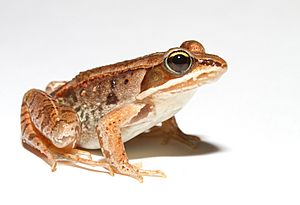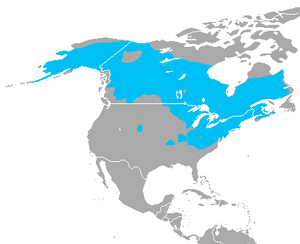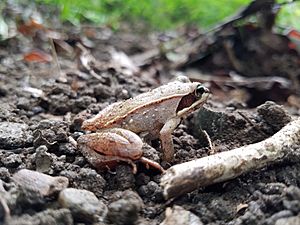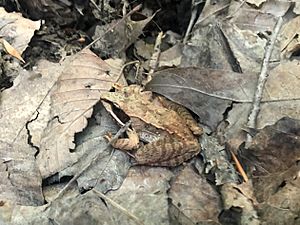Wood frog facts for kids
Quick facts for kids Wood frog |
|
|---|---|
 |
|
| Conservation status | |
| Scientific classification | |
 |
|
| Geographic range of the wood frog in North America (in blue) | |
| Synonyms | |
|
The wood frog is a special type of frog found all across North America. Its scientific names are Lithobates sylvaticus or Rana sylvatica. These frogs are known for their amazing ability to survive freezing temperatures.
Contents
What Does a Wood Frog Look Like?

Wood frogs are usually about 51 to 70 mm (2.0 to 2.8 in) long. That's about the length of your thumb! Female wood frogs are typically bigger than males.
Most adult wood frogs are brown, tan, or a rusty color. They often have a dark mask around their eyes, which helps them blend in. Interestingly, a single frog can change its color. It might look light brown at one time and dark brown at another.
Their bellies are usually pale, sometimes with a yellow or green tint. In colder northern areas, their bellies might have faint spots. Their body color can also change with the seasons. They might get darker if they spend more time in the sun.


Where Do Wood Frogs Live?
Wood frogs live in a huge area across North America. Their home stretches from northern Georgia in the east to Alaska and southern British Columbia in the west. They are the most common frog found in Alaska. You can also find them in places like the Medicine Bow National Forest.
Wood Frog Habitats
Wood frogs like moist places. They prefer:
- Forests and woodlands.
- Wetlands like bogs and marshes.
- Sometimes, they can even be found in cold tundra or open grasslands.
For breeding, they need temporary or permanent water bodies. These can be small ponds or special pools that form only in spring, called vernal pools.
How Do Wood Frogs Survive?
Wood frogs have some incredible ways to survive in their environment.
Amazing Freeze Tolerance
The wood frog is famous for its ability to survive freezing solid during winter. Imagine being able to freeze and then thaw out perfectly fine! This is one of their most amazing adaptations.
Excellent Camouflage
Their brown and tan colors help them hide very well. They can blend right into the leaf litter and forest floor. This keeps them safe from animals that might want to eat them.
Wood Frog Life Cycle and Behavior
Breeding and Reproduction
Wood frogs start breeding very early in spring. This often happens in temporary pools or ponds created by melting snow.
- Males make a special quacking or chuckling sound to attract females.
- Females lay large masses of eggs, sometimes hundreds at once.
- These eggs hatch into tadpoles within a few weeks.
What Do Wood Frogs Eat?
Adult wood frogs are carnivores. They eat:
- Insects
- Spiders
- Worms
- Other small invertebrates (animals without backbones)
Tadpoles, on the other hand, are herbivorous. They mostly eat algae and tiny plant bits found in the water.
When a wood frog catches food, it lunges forward. It opens its mouth and quickly extends its sticky tongue to grab the prey.
Winter Hibernation
Wood frogs spend the winter hibernating. They often hide under leaf litter or buried in the soil. Their unique ability to freeze and then thaw out lets them live in very cold places where other amphibians cannot.
Why Are Wood Frogs Important?
Wood frogs are very important to their ecosystems.
- They help control insect populations by eating them.
- They are also a food source for other animals, like birds, snakes, and small mammals.
Because they are sensitive to changes in their environment, wood frogs are considered an "indicator species." This means that if wood frogs are healthy, it's a good sign that the whole ecosystem is healthy too!
Are Wood Frogs in Danger?
The good news is that wood frogs are currently listed as Least Concern by the IUCN. This means they are not in immediate danger. They have a wide range and their populations are stable.
However, there are still some potential threats:
- Habitat loss: When their homes (forests and wetlands) are destroyed.
- Pollution: Harmful chemicals in their water or land.
- Climate change: Changes in weather patterns can affect their breeding and survival.
Fun Facts About Wood Frogs!

- Wood frogs living in southern Canada and the American Midwest can survive temperatures as low as -3 to -6 °C (about 21 to 27 °F).
- Up to 65% of a wood frog's body water can freeze solid! Their heart and breathing can even stop.
- They do this by making a lot of glucose (a type of sugar) in their bodies. This glucose acts like a natural antifreeze, protecting their cells from damage.
- Wood frogs are mostly active during the day. You rarely see them at night.
- They are one of the first amphibians to come out and breed in spring, right after the snow melts. They often breed at the same time as spring peepers.
- The wood frog has been suggested as the official state amphibian for New York.
See also
 In Spanish: Rana de bosque para niños
In Spanish: Rana de bosque para niños



